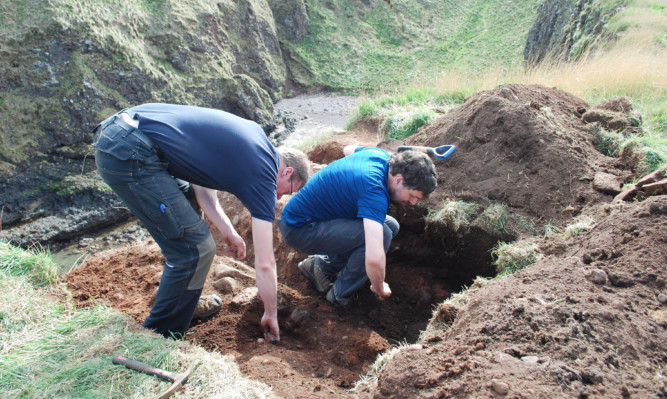A Pictish fort on an inhospitable sea stack is believed to be the oldest in Scotland, archaeologist have said.
Carbon dating from the site south of Stonehaven in Aberdeenshire suggests it dates from the third or fourth century, making it the oldest Pictish fort ever discovered.
Archaeologists from the University of Aberdeen needed help from experienced mountaineers to scale the rocky outcrop, which measures at most 20 by 12 metres and is surrounded by sheer drops on all sides.
Once on the site, known as Dunnicaer, they dug five trenches which yielded a number of finds, including evidence of fortified enclosure walls and terraces and the remains of a stone hearth.
Dr Gordon Noble, a senior lecturer in archaeology at the university, said: “This is the most extreme archaeology I’ve ever done. The site can only be accessed using ropes at low tide and having never climbed before, it was quite hair-raising. But the challenge of getting to the top was soon forgotten as we began to make significant discoveries.
“We knew that the site had potential as in 1832 a group of youths from Stonehaven scaled the sea stack, prompted by a local man who had recurring dreams gold was hidden there.
“Unfortunately for the youths they didn’t find the gold, but they did find a number of decorated Pictish symbol stones and as they were throwing them into the sea, noticed some were also carved.
Several years later, when knowledge of Pictish stones began to circulate, a number were recovered from the sea.
“We’ve always thought these symbol stones either strange or very early as the carvings are ‘rough and ready’ compared to other known Pictish symbol stones and this is what prompted us to excavate Dunnicaer.”
Dr Noble said Dunnicaer appears to have been home to a “significant fort”, with ramparts constructed of timber and stone.
He added: “The stone is not from the local area so it must have been quite a feat to get it, and the heavy oak timbers, up to such an inaccessible site.
“It is likely that the sea stack was greater in size than it is today as the fort appears to extend over a large area. Dunnicaer was likely to have been a high status site for a structure of this scale and complexity to have been present as early as the 3rd century.”
However results of the carbon dating suggest that use of Dunnicaer was relatively short-lived and it is assumed the Pictish communities who inhabited it moved on to the larger site of Dunnottar Castle to the south.
Aberdeenshire Council archaeologist Bruce Mann said: “The dates for this site are truly amazing, and hugely important for Scottish archaeology.
“Towards the end of the third century AD evidence of how and where people were living largely disappears, leading to all sorts of speculation over what happened during the next 200 years.
“This discovery now starts to not only fill in that missing story, but also helps us to understand the early origins of the Picts in the north east.”
The excavation took place in April.
